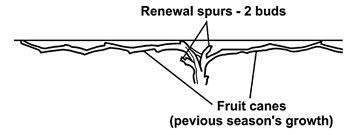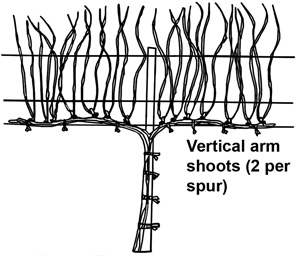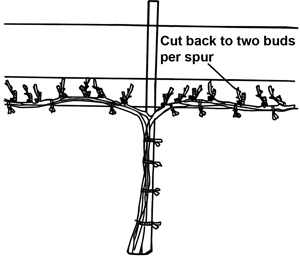From the University of Georgia Cooperative Extension
College of Agriculture and Environmental Sciences
Pruning the Bearing Vine
Excerpts from the Home Garden Bunch Grapes publication
Grapes require annual pruning to maintain
quality and productivity. Prune during the dormant season. Because of
our mild climate, prune during February. Late winter or spring pruning
will cause “bleeding” (flow of sap through the pruning
wounds), but this should not cause alarm since it does not damage the
plant.
Note: Pruning is done in Florida during the following
dormant periods: (a) south Florida: January; (b) central Florida: January
1 to February 15; and (c) north Florida: January 1 to March 10. 2
Two Types of Training/Pruning:
Cordon Training/Spur Pruning and Head Training/Cane Pruning
Two
very different types of pruning are used on bunch grapes. While cordon
training/spur pruning is by far the most popular training/pruning
combination, many vineyard owners also employ head training/cane
pruning, particularly in hybrid grapes trained to low trellis systems
with vertical shoot positioning. With cane pruning, only the trunk is
permanent. The cordons (arms) are formed by leaving several of last
year’s canes. With spur pruning, the trunk and the cordons are
permanent and the current season’s growth is cut back to short shoots
(spurs).
Head Training/Cane Pruning
Do
not over crop third year vines. Thin the fruit clusters to one per
shoot. Most mature vines (typically 4 years and older) should be pruned
to have between 30 and 60 buds. The more vigorous the vine, the more
buds should be left. Balanced pruning, a method of pruning to balance
production and vine vigor, is recommended for two wire systems. To
balance prune, select four canes of last summer's growth, one for each
direction on the two wires. See Fig. 1.

|
Fig. 1
Grape
vine properly pruned showing fruiting canes and renewal spurs. Each
cane on the double curtain or two wire vertical trellis should be
pruned similarly to this. |
One
benefit to head training/cane pruning is that most shoots that arise
from the retained canes are fruitful, and basal/non-fruitful shoots are
minimized, thus minimizing the need for shoot thinning to prevent
fruitzone overcrowding. One drawback to head training/ cane pruning is
that once the canes that will be retained are selected, they must also
be tied down to the fruiting wire. These should be selected from canes
arising from the head (the region where the vertical trunk “splits” and
is trained horizontally to the fruiting wires) of the vine. Canes about
the diameter of a pencil are most desirable. Gather up all of last
season’s canes pruned from the vine and weigh them. Note: Do not weigh wood that is greater than one year old.
As a rule of thumb, 30 buds should be left on the vine for the first
pound of prunings removed, and 10 buds for each additional pound. Vines
producing less than .75 pound of prunings should not be cropped. As an
example, suppose a vine (after pruning where 60 buds were left) yielded
3.5 pounds of prunings. Then the number of beds to be left would be
about 55 (30 for the first pound and 25 for the other 2.5 poungs). Each
of the four canes left should be pruned back to have about 14 buds each
(14 buds x 4 canes = 56 totoal buds). If balanced pruning is not to be
done, then 30 to 60 buds should be left; the greater number being left
on the most vigorous vines. Leave renewal spurs in the head region to
form canes for next year (Fig. 2). These spurs are also canes of last
season’s growth pruned back to leave only two buds each. From these
spurs will grow the fruiting canes for next year. Renewal spurs should
be located as near the trunk(s) as possible.
Leave renewal spurs in the head region to form canes for next year Fig. 1.
These spurs are also canes of last season's growth pruned back to leave
only two buds each. From these spurs will grow the fruiting canes for
next year. Renewal spurs should be located as near the trunk(s) as
possible.
Cordon Training/Spur Pruning
Cordon
training/spur pruning is more popular than head training/cane pruning,
and this is perhaps due to the ease with which it is executed. It is
primarily used on highwire systems such as the double curtain or single
high wire. One drawback to cordon training/spur pruning is that
diseases can form in the cordons over time. Further, several
basal/non-fruitful shoots can grow from the cordon; as a consequence,
the fruit-zone can become overcrowded and more susceptible to fungal
diseases due to reduced air movement and fungicide coverage on the
fruit. This, however, can be mitigated by selective fruit-zone leaf
removal (see below).
Single wire low trellis with catch arms
— In
late winter cut back side shoots that grew the previous summer (now dormant, woody canes). This
forms the “spurs.” Leave two to three buds per spur for
French hybrid grapes (Fig. 2,3) and four to six buds on American type bunch
grapes. Select shoots that grew upward in a well-lighted environment to
have the most fruitful spurs. Remove weak shoots.
In
the spring, allow four to six shoots per foot of cordon to develop,
removing basal shoots (those arising from regions other than the
one-year-old retained spurs). These leaves can be removed shortly
after bloom but before the berries begin to change color and soften. Do
not remove leaves after the berries begin to soften because sunburn may
result. Thin fruit clusters to no more than two per shoot. As the new
shoots become long enough, place them into the catch wires.

|

|
Fig. 2
Mature French hybrid on low wire cordon before winter pruning |
Fig. 3
Mature French hybrid on low wire cordon after pruning. |
Further Reading
Home Garden Bunch Grapes, University of Georgia, Cooperative Extension pdf
Grape Trellis Systems, University of Georgia, Cooperative Extension
Training Young Vines, University of Georgia, Cooperative Extension
Back to
Bunch Grape Page
Pruning and Training Page
|
|
Bibliography
1 Krewer, Gerard. "Home Garden Bunch Grapes."University
of Georgia, Cooperative Extension,
Published with Major Revisions 15 Oct. 2006, Minor Revisions 5 Jan. 2010, Full Review 1 Jan. 2014, Minor Revisions 13 June 2017,
extension.uga.edu/publications/detail.html?number=B807&title=Home%20Garden%20Bunch%20Grapes. Accessed 10 Oct. 2018.
2 Andersen, Peter C. "The
Bunch Grape." Horticultural Sciences Dept., UF/IFAS Extension,
HS-17A, Original pub. Aug. 2001, Revised Apr. 2014, and May 2017, Reviewed June 2020, AskIFAS, edis.ifas.ufl.edu/mg105.
Accessed 17 Sept. 2018, 28 Sept. 2020.
Published 8 Nov. 2014 LR. Last update 5 June 2023 LR
|


